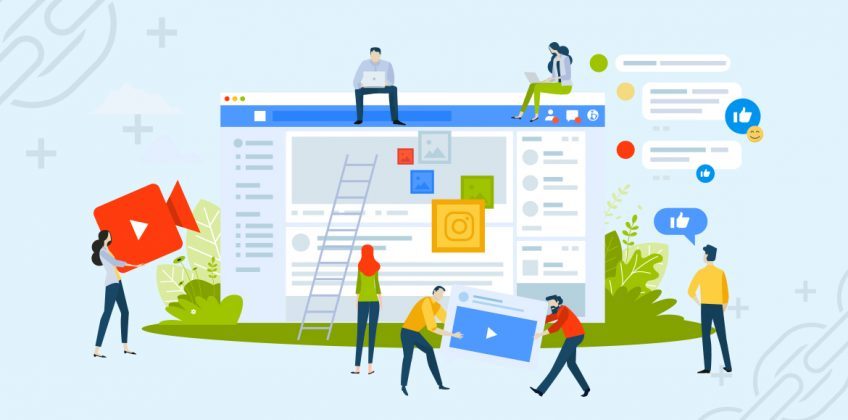More students tend to enroll in higher studies throughout the world. It is expected that by 2025 the number will reach 300 million.
Among this growing demand for higher education, the expected revenue of educational institutes is expected to make more than 35.03 billion US dollars by 2025.
Also, with the increase in popularity of digital platforms like Google, Facebook, Twitter, Instagram & other digital platforms, the majority of the population engages online.
Therefore, the institutions are realizing that only offline promotion is not adequate for marketing. Due to Covid-19, digitalization has taken a height at a different pace, which was not expected earlier.
Marketers from all industries prefer digital marketing in such a condition, and the education industry is not an exception. For maintaining the competitive edge, to attract and engage with more people online, the learning institutes want to concentrate more on online marketing.
Importance of online marketing techniques for educational institutions
This is not to be said, you all know it better – nowadays, if people need anything, at first, they search it online, especially on Google & other search engines. They also check social media channels to check the credibility and reviews from other people, before making any purchase decision.
A large number of the population spend most of their time on the internet, especially students. Apart from playing online games, and other stuff, in a modern learning system, students need to complete many assignments also. They need to add specific data for which digital medium is the most trustworthy & in-reach platform for them.
Students also search for information regarding various courses, admission fees, sessions, college positions, rankings, results, and many more. Job prospects are another thing that learners want to know about the institutes where they would take admission.
So, educational institutions should effectively use digital platforms. They should include every detail that can offer the students an excellent overview of the courses and services they offer.
In recent times parents and learners prefer those educational institutions that have a strong internet presence. As a result, educational institutes also like to promote themselves digitally over traditional promotional strategies.
For dominating the internet, digital marketing is highly crucial. It builds consciousness, supports the promotion, and creates online reliability for any learning institute. There are some benefits of strategic digital marketing:
- Helpful in creating brand value:
Making your target audience aware of your brand is crucial; as discussed earlier, the education industry is also very competitive like other industries. Therefore, to continue your educational institution, you need to establish your institute as the best within the industry.
The world is now using digital mediums as much as possible. The young learners’ community and their guardians search online to get information regarding the best learning institute. Therefore, a proper marketing strategy of the educational institution will support approaching the target learners. This way, you can create a brand value.
- Explain the courses you offered:
After successfully developing your brand awareness, more visitors will likely visit your website. Now it’s the time for educational institutions to highlight the courses they offer to their students and their benefits. Don’t forget to explain activities you have other than the curriculum. All the information should be strategically arranged so that visitors can quickly see them while visiting your page. The educational institutions which can place relevant information strategically can promote their brand more efficiently.
- Building reliability:
Recent students and guardians don’t rely on schools, colleges, and institutes that don’t have an online presence. The reason is that they can’t understand whether you are an authentic institution or not. So, keep posting your strengths on your website and your social media account. This will help you to create authenticity and build trust.
- Target potential audience via social networking sites:
In digital marketing, social media plays a significant role. You can target possible audiences and can directly communicate with them. You can make reels, short videos, stories and post them regularly on your social media account. It will attract more visitors, and you can convert the visits into admissions. Organic results may take some time, so for immediate results, you can consider paid social media campaigns also.
- Convert visits into enrollments:
Online promotional ads are less expensive than tv ads and more effective for approaching prospective clients. Systems like geotagging allow even small-budget institutes to reach their targeted clients within an affordable budget.
Digital marketing helps the visitors in making a fast decision and is thus effective for increasing conversion rates.
Top online marketing strategies for learning institutes
Digital Marketing offers desired results only when it is executed strategically. Educational institutes must plan their digital marketing strategies around their planned goals. If required, you can contact some professional and experienced digital marketing strategists or can reach us as well. Here are some best effective digital marketing practices that educational institutions should follow:
1. Create a high-standard website
If you want the successful branding of your educational institution, then you must have a world-class website. Your website should contain every minute detail regarding your courses, activities, employees and teachers, job opportunities, etc. It would help to emphasize the key benefits of your organization that keep your students ahead of other institutes. These details help the visitors to make fast decisions and increase their enrollment.
While creating your website, please remember that maximum students browse through mobile. So, your website should be mobile optimized with the good page loading speed and engaging content.
2. Try to remain continuously available on chatbots
Chatbots are transforming online interaction practices, and it is helpful to make quicker communications. The bots can reply instantly to the visitors’ questions.
Chatbots, if properly used, can be highly beneficial for learning institutes. Ensure that any of your representatives are always available on chatbots. This will enable you to answer the queries of the students and parents immediately.
3. Have a presence on top social networking sites
When marketing online, try to have accounts on leading social networking sites like Facebook, Twitter, Instagram, YouTube.
Here you can post the videos on your activities, create stories, post images and get likes, comments, and shares. This way, you can increase your followers. It will broadly impact an institution’s organic search ranking on a search engine.
4. Interact through live sessions
Social media platforms offer you the opportunity to interact directly with your followers live. Education institutions should make use of these opportunities. They can invite their targeted audience to join their live session.
While going live, they can directly listen to the queries, issues, or curriculum-related questions. It would be best to go live with your existing students to share their educational experiences with those joining when you go live.
5. You must have quality content
Your rewards and achievements in your field are an indicator of the quality service you provide. And the best way to showcase your achievements is to include them in content. Your content needs to have motivational speeches, audio-visuals, and other animated documents. It will motivate the parents and the learners to choose your institution.
Always try to include subtle matters into your content that can increase your student enrollment. Include your strengths, campus details, branches, if there are any, job offers for students, fees, installments, and other services you show. Detail and transparent descriptions will insist your targeted audience think about you.
6. Pay attention to the paid search and SEO
Paid search is always an effective tool while promoting your institute online. Showing your ads online is more beneficial than displaying them on tv. This is one of the most powerful strategies that many education marketers implement for their branding.
Along with paid search, organic Search Engine Optimization practices can’t be neglected for success in the long term.
Conclusion
It is suggested that before getting digital, every educational institution should decide its goals and strategies for accomplishing them. Online marketing practices are continuously changing. So, marketers also keep on changing strategies as per the needs of their target audience.
If you need any strategy for your institution/s or any execution support, feel free to reach the Get Digital team at our coordinates.





